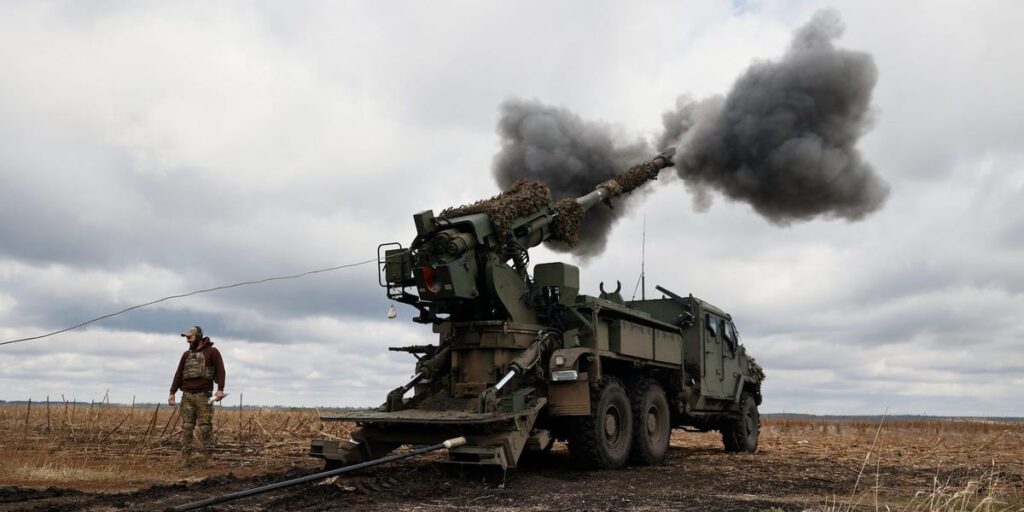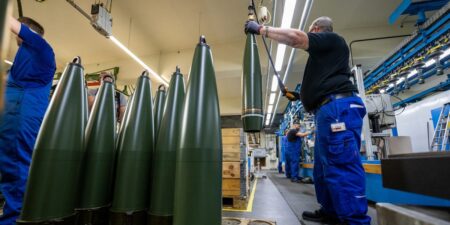Ukraine was able to supercharge the production of a key homemade artillery system through a new way allies are employing to arm Ukraine faster and cheaper. It could be the new template for helping Ukraine arm itself against Russia.
Ukraine has significantly boosted its production of the 2S22 Bohdana 155mm howitzers with funds from allies under the new funding system, industry bodies that represent Ukrainian defense companies told Business Insider. Artillery systems remain critical in this war.
For much of this conflict, Western partners have sent their weapons to Ukraine, emptying stockpiles. This new model involves partners purchasing weapons for Kyiv’s forces directly from Ukrainian manufacturers. The former approach is still key for Ukraine, but the latter has shown real potential.
The new system, pioneered by NATO member Denmark and nicknamed the Danish Model, has helped Ukraine get more weapons for it to fight back against Russia’s invasion.
In particular, it has had a really “significant impact” on Bohdana production, Serhiy Goncharov, the CEO of the National Association of Ukrainian Defense Industries (NAUDI), told Business Insider. His group represents around 100 Ukrainian companies.
Production increased from six units a month in 2023 to more than 20 of these systems in 2025, according to Ukraine’s Defence Procurement Agency.
The Bohdana is a NATO-standard, self-propelled howitzer produced by Ukraine’s Kramatorsk Heavy Duty Machine Tool Building Plant, and Goncharov described it as “a symbol of resistance and the symbol of Ukrainian industry.”
Funding weapons that are made in Ukraine is important given current challenges. European military stockpiles have little to spare for Ukraine, and many Western defense companies already have big backlogs in production. So even funding new Western weapons doesn’t help Ukraine in the short term. Ukraine frequently deals with shortages of foreign weapons from its partners given the war’s tremendous demand for war material.
The model is also useful for NATO, with many countries in the alliance wanting to maintain and grow their own arsenals, worried that Russian aggression could someday extend beyond Ukraine.
Goncharov said that the Danish model has helped Ukrainian industry scale production by giving it the finance it needs, as usually it is limited to what Ukraine’s defense ministry can afford, which is out of sync with industrial capacity.
That financial support, he said, gives producers “more confidence” to increase their production, knowing the funding is there. In addition to the homemade howitzers, the Danish model has helped fund more drones, as well as anti-tank and anti-ship missile systems.
A host of countries, like Sweden and Iceland, are giving money to Ukraine through the model, which is growing.
In 2024, the model finalized procurements for weaponry worth more than $550 million, and Ukrainian Defence Minister Rustem Umerov said last month that support through this model is expected to reach more than $1.7 billion this year. And more partner countries are continuing to join while some countries, like Germany, are launching independent programs inspired by the model.
New help for Ukraine
Troels Lund Poulsen, Denmark’s defense minister, told Business Insider in March that the model so far “has been a great success” and that under it, the weapon prices are “quite low compared to buying the artillery systems in Europe.”
Goncharov called the model a “new vision of how you can support Ukraine” and said that work on the Bohdana was a big “success story.”
He said NAUDI has a list of weapons that it is ready to make more of through the Danish model or a similar model, including artillery, armored vehicles, jamming systems, and drones.
Ihor Fedirko, the CEO of the Ukrainian Council of Defence Industry (UCDI), a body that represents more than 100 companies, told Business Insider that the increase in Bohdana production was “made possible thanks to the Danish model and associated funding.”
And the capacity exists for increased total production, he said. Fedirko described the Danish model as “the largest hope for the private sector” in Ukraine.
Within Ukraine’s defense industry, “there are huge hopes and expectations in terms of the Danish model, and we hope that far more countries will join it,” Fedirko said.
He said that would strengthen Ukraine’s defense capabilities, “so this is why the private market is very much looking forward to its further unfolding.”
Ukraine’s defense industry
Private companies have been essential to Ukraine’s fight against Russia’s invasion. The domestic defense sector has exploded, developing and testing new weaponry that is then purchased by Ukraine’s military and sometimes by units buying directly.
Ukrainian President Volodymyr Zelenskyy said 30% of the military equipment Ukraine used in 2024 was made in the country. He said recently that has climbed to 40%.
Fedirko said there are around 700 market players in Ukraine’s defense industry, with just 76 of those being state-owned.
The Danish model helps with a problem that is facing Ukraine’s defense industry and military, which is that its defense companies have the ability to produce far more weaponry than Ukraine’s government can afford to buy.
Goncharov said that “our capacity of the Ukrainian producers is at least three times higher than our potential to purchase.” If it does not receive outside support, the defense sector is limited by the Ukrainian budget.
Goncharov said that in Ukraine, “we are ready to increase our production,” if more purchases are made. The Danish model lets Europe arm Ukraine without emptying its stockpiles.
He said sometimes defense companies can be “sitting in the office and have no contract at all” but be ready to produce. The Danish model gives companies the financial means to keep producing, he said.
He said he hoped for increased cooperation with Europe, as he sees Ukraine as holding back Russia. “The European Union should understand that we are not fighting not only for Ukraine, that we are fighting for Europe.”
Read the full article here
















